Live Chat vs Chatbot Comparing Strengths and Weaknesses
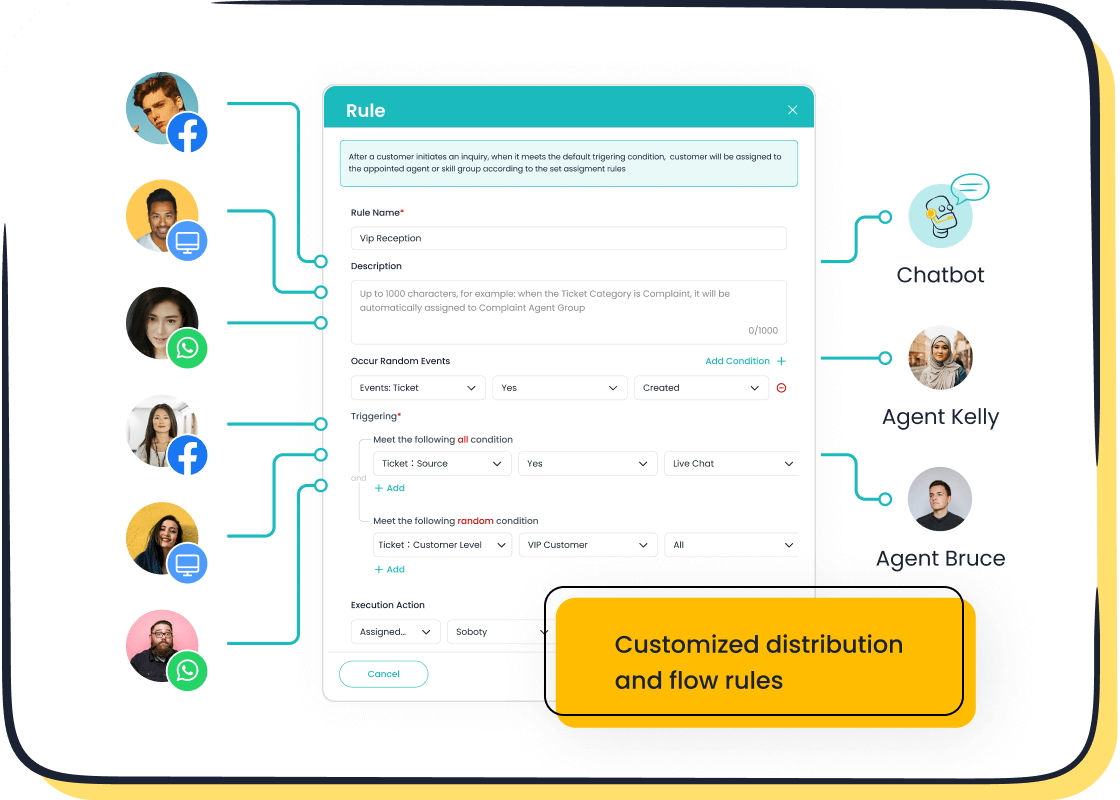
When it comes to customer support, the debate between chatbot vs. live chat often arises. Both tools offer unique advantages, but their effectiveness depends on your business needs. For instance, live chat support has proven to enhance customer loyalty, with 79% of companies reporting increased sales and revenue. On the other hand, chatbots can independently resolve up to 80% of customer issues, making them a cost-effective solution for repetitive tasks.
Choosing the right tool requires careful consideration of your goals. Do you prioritize the human touch of effective live chat support, or do you need the scalability of chatbots? Sobot, a leader in customer engagement solutions, offers both live chat and chatbot services to help businesses deliver exceptional customer experiences.
Overview of Live Chat and Chatbots
What is Live Chat Support?
Live chat support allows you to communicate with customers in real time through a digital platform. It connects your customers directly to human agents who can answer questions, solve problems, and provide personalized assistance. This tool is often integrated into websites, apps, or social media platforms, making it accessible and convenient for users.
One of the key benefits of live chat is its ability to provide empathetic and human-centered customer service. Agents can understand the emotions behind a customer’s query and respond accordingly. However, live chat depends on the availability of agents, which may limit its use outside of business hours unless additional resources are allocated.
What is a Chatbot?
A chatbot is an automated tool powered by artificial intelligence (AI) that interacts with customers through text-based conversations. Chatbots are designed to handle repetitive and straightforward queries, such as checking order statuses or answering frequently asked questions. They operate 24/7, ensuring that your customers receive instant responses at any time.
Chatbots offer several advantages, including cost-effectiveness and scalability. For example, they can handle unlimited queries simultaneously without delays. Additionally, chatbots often support multiple languages, making them ideal for businesses with a global customer base. However, they may struggle with complex issues that require human judgment or emotional understanding.
Chatbot vs. Live Chat: Key Differences
Understanding the differences between chatbots and live chat can help you choose the right solution for your business. The table below highlights some key distinctions:
| Aspect | Live Chat | Chatbot |
|---|---|---|
| Handling complex issues | Suitable for detailed explanations. | Best for simple and repetitive questions. |
| Volume of customer requests | Limited by agent capacity. | Handles multiple queries efficiently. |
| Availability requirements | Restricted to business hours. | Operates 24/7 with instant responses. |
| Cost efficiency | Higher due to staffing needs. | More cost-effective for routine tasks. |
| Customer experience expectations | Offers human empathy and understanding. | Provides quick but emotionless responses. |
| Scalability | Requires more agents as demand grows. | Easily scalable without additional resources. |
While live chat excels in providing a personal touch, chatbots shine in efficiency and availability. Combining both tools can create a balanced customer support strategy that meets diverse needs.
Advantages of Chatbots
Cost-Effectiveness and Scalability
Chatbots offer a cost-effective solution for handling customer queries. Unlike live chat, which requires human agents, chatbots can manage multiple conversations simultaneously without additional staffing costs. This scalability makes them ideal for businesses experiencing high volumes of customer interactions.
Consider the following data highlighting the cost-effectiveness of chatbots:
| Evidence Description | Value |
|---|---|
| Percentage of enterprise operating costs attributed to human support agents | 60% - 70% |
| Employee compensation costs as a percentage of operating costs in customer support | 26.1% - 55.3% |
| Estimated percentage of end-user queries that can be addressed by self-service | 60% - 80% |
By automating repetitive tasks, chatbots reduce operational expenses and free up resources for more complex customer service needs. This efficiency allows you to scale your support operations without compromising quality.
24/7 Availability for Customer Support
One of the most significant advantages of chatbots is their 24/7 availability. Unlike live chat support, which depends on agent availability, chatbots operate around the clock. This ensures your customers receive instant responses, regardless of time zones or business hours.
Here are some key benefits of 24/7 chatbot availability:
- It meets customer expectations across different time zones.
- Continuous support enhances customer satisfaction and loyalty.
- Faster response times reduce wait times, improving the overall experience.
With chatbots, you can provide uninterrupted customer support, ensuring no query goes unanswered.
Consistency in Responses
Chatbots excel in delivering consistent and accurate responses. They rely on pre-programmed data and AI algorithms, ensuring uniformity in addressing customer queries. This consistency builds trust and reliability in your customer interactions.
The following statistics demonstrate the impact of chatbot consistency:
| Statistic | Percentage |
|---|---|
| Users rating information as reliable | 69% |
| Users seeing simplified ticket response | 84% |
| Users noting increased personalization | 64% |
| Boost in productivity for CS specialists | 94% |
| Speed up in issue resolution | 92% |
| Reduction in agent effort | 87% |
| Reported lowered costs due to efficiency | 65% |

By maintaining consistency, chatbots not only improve customer satisfaction but also enhance the efficiency of your customer support operations.
How Sobot's Chatbot Enhances Customer Interactions
Sobot's chatbot transforms how you engage with your customers by offering intelligent, efficient, and personalized support. Designed with advanced AI capabilities, it ensures seamless interactions that meet modern customer expectations.
One of the standout features of Sobot's chatbot is its ability to handle high volumes of queries simultaneously. For example, during peak shopping seasons, businesses often experience a surge in customer inquiries. Sobot's chatbot can manage these spikes effortlessly, ensuring no customer waits for assistance. This scalability not only improves efficiency but also enhances customer satisfaction.
The chatbot also excels in providing multilingual support. If your business serves a global audience, Sobot's chatbot can communicate in multiple languages, breaking down language barriers. This feature ensures that every customer feels valued and understood, regardless of their location.
Another way Sobot's chatbot enhances interactions is through its integration capabilities. It connects seamlessly with platforms like Salesforce and Shopify, allowing you to access customer data in real time. This integration enables the chatbot to offer personalized responses, making your customers feel like their needs are truly understood.
Additionally, Sobot's chatbot operates 24/7, ensuring your customers receive instant responses at any time. Whether it's a simple query about order status or a more detailed question, the chatbot provides consistent and accurate answers. This reliability builds trust and strengthens your relationship with your customers.
Sobot's chatbot doesn't just stop at answering questions. It also collects valuable insights through built-in analytics. These insights help you understand customer behavior, identify trends, and make data-driven decisions to improve your services.
By choosing Sobot's chatbot, you equip your business with a tool that not only enhances customer interactions but also drives operational efficiency. It’s a solution that combines innovation with practicality, ensuring your business stays ahead in a competitive market.
Disadvantages of Chatbots
Limited Ability to Handle Complex Queries
Chatbots often struggle when faced with complex customer issues. Their reliance on pre-programmed scripts and limited creativity can result in generic or irrelevant responses. For example:
- Chatbots lack critical thinking skills, which are essential for analyzing intricate problems.
- They may misinterpret ambiguous queries, leading to confusion or frustration.
- Many chatbots fail to provide creative solutions for unique situations, leaving customers dissatisfied.
Additionally, chatbots depend heavily on their training data. If the data lacks depth or context, their ability to handle specialized inquiries diminishes. This limitation becomes evident in industries requiring domain-specific knowledge, such as financial services or healthcare. Customers often find that chatbots cannot fully understand their needs, with 60% of consumers believing humans are better at addressing their concerns.
Lack of Personalization in Customer Support
One of the major disadvantages of chatbots is their inability to deliver personalized customer service. Interactions often feel robotic and impersonal, as chatbots cannot adapt their responses based on individual preferences or past interactions. This lack of personalization can lead to disengaged experiences and customer frustration.
Consider these challenges:
- Chatbots fail to tailor responses to unique customer needs, often providing generic answers.
- They cannot learn from previous conversations, which prevents them from building meaningful connections with customers.
- Customers expect personalized experiences, and when chatbots fall short, they may lose trust in the brand.
Personalization plays a crucial role in customer support. Without it, customers may feel undervalued and seek alternatives, impacting your business's reputation and customer loyalty.
Risk of Miscommunication
Chatbots rely on keywords and pre-set algorithms to interpret customer queries. This approach increases the risk of miscommunication, especially when dealing with nuanced or context-heavy conversations. For instance:
- Chatbots may provide irrelevant information if they misinterpret the context of a query.
- They struggle to distinguish between general inquiries and specific issues, leading to confusion.
- Limited integration with business systems can result in outdated or inaccurate responses.
These challenges can frustrate customers, especially when they cannot find quick solutions to their problems. Miscommunication not only affects the customer experience but also reduces the overall effectiveness of your customer support strategy.
Customer Frustration with Automated Responses
Automated responses from chatbots can sometimes leave customers feeling frustrated. While chatbots provide quick answers, they often fail to meet customer expectations in more complex or nuanced situations. This gap between what customers need and what chatbots deliver can lead to dissatisfaction.
One major issue is the inability of chatbots to understand specific needs. Many customers report that chatbots fail to answer their questions or even recognize the context of their inquiries. This lack of understanding can make interactions feel robotic and unhelpful. For example, two-thirds of customers say chatbots cannot answer their questions or understand their needs. This highlights a significant limitation in automated systems.
Another common frustration arises when customers cannot easily connect to a live chat agent. Many automated systems, such as IVR (Interactive Voice Response), fail to route customers to human support when needed. Half of the customers surveyed expressed frustration with IVR systems for this reason. This inability to escalate issues to a human agent can make customers feel stuck and unheard.
The following table summarizes key statistics about customer frustration with automated responses:
| Statistic | Description |
|---|---|
| 66% | Customers reporting a bad chatbot experience |
| 66% | Customers reporting a bad experience with IVR |
| 60% | Customers having a bad experience with IVR prompts |
| 50% | Customers frustrated with IVR not routing to a live agent |
| 2/3 | Customers citing chatbot's inability to answer questions |
| 2/3 | Customers citing chatbot's failure to understand needs |
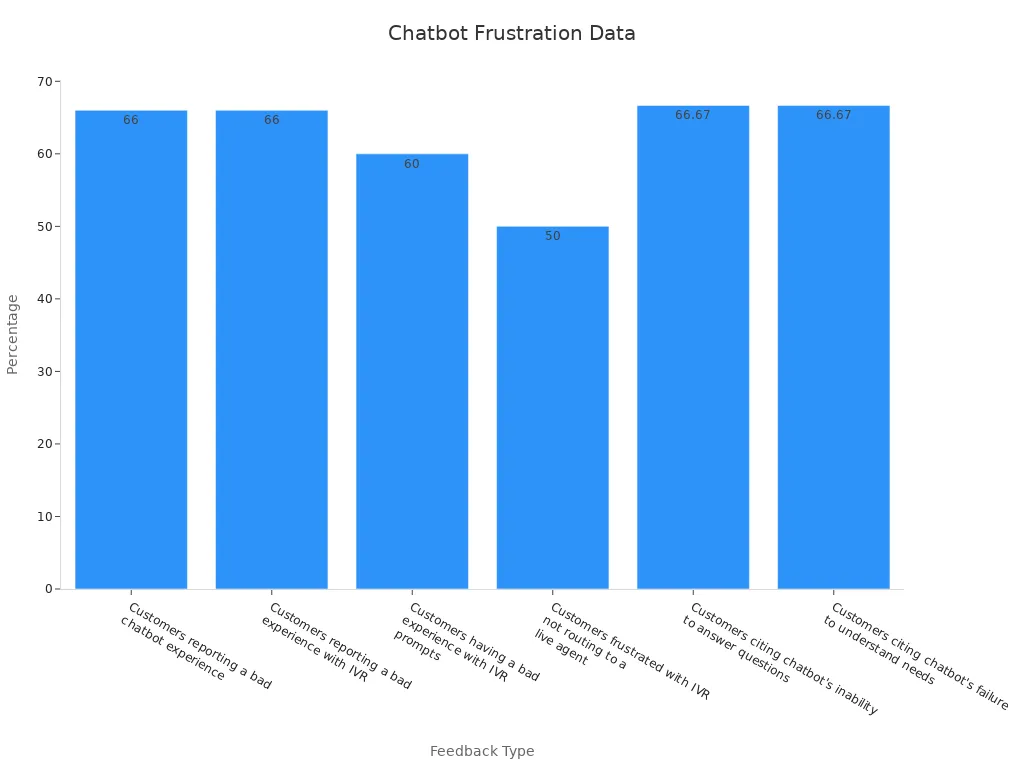
These frustrations highlight one of the key disadvantages of chatbots: their inability to provide the human touch that live chat offers. While chatbots excel in efficiency, they often lack the empathy and adaptability that human agents bring to customer interactions. This is why many businesses choose to combine chatbots with live chat to balance automation with personalized support.
Advantages of Live Chat
Human Touch and Empathy in Live Chat Support
Live chat support stands out because it offers the human touch that automated systems cannot replicate. When customers interact with live agents, they experience empathy and understanding, which builds trust and loyalty. Unlike chatbots, live agents can interpret emotions and respond with care, making the interaction feel personal and meaningful.
For example, 70% of customers prefer speaking with human agents over AI technology. This preference highlights the importance of empathy in resolving issues. Additionally, 94% of consumers believe positive experiences with live agents lead to repeat business. These statistics emphasize how live chat fosters stronger relationships with your customers.

Ability to Handle Complex Customer Issues
Live chat excels in addressing complex customer issues that automated systems often fail to resolve. Human agents can provide personalized responses, interpret customer intent, and adapt to unique situations. This flexibility ensures that even the most intricate problems receive proper attention.
Unlike chatbots, which handle straightforward inquiries, live agents can navigate errors in communication and clarify misunderstandings. For instance, they can offer tailored solutions by understanding the context of a problem. This ability to think critically and creatively makes live chat an invaluable tool for businesses.
- Live chat enables agents to deliver personalized responses.
- Human agents interpret customer intent more accurately than chatbots.
- Complex issues often require the adaptability that only live agents can provide.
Higher Customer Satisfaction Rates
The advantages of live chat support extend to higher customer satisfaction rates. Customers appreciate the quick and effective solutions provided by live agents. On average, live chat sessions have a waiting time of just 36 seconds and a duration of 11 minutes and 9 seconds, ensuring timely assistance.
Statistics further validate the effectiveness of live chat. For example:
- 92% of consumers report greater satisfaction with live chat compared to other channels.
- 63% of customers are more likely to return to a website offering live chat.
- 94% of clients invited to live chat sessions express high satisfaction.
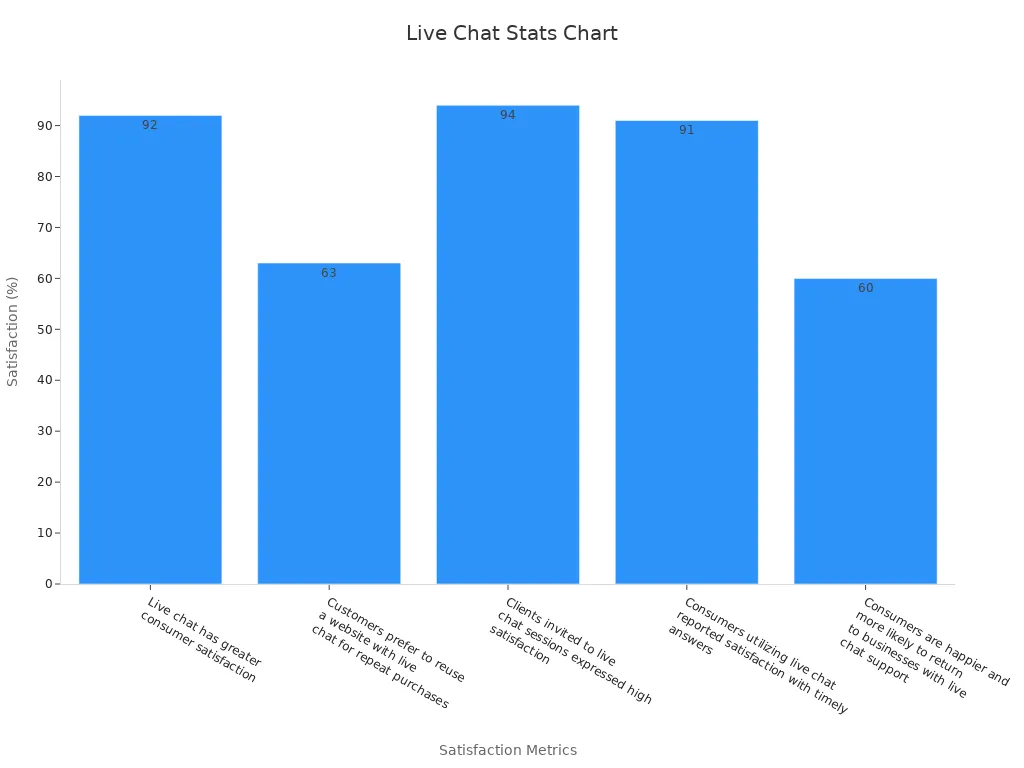
These numbers demonstrate how live chat enhances the overall customer experience, making it a preferred choice for many businesses.
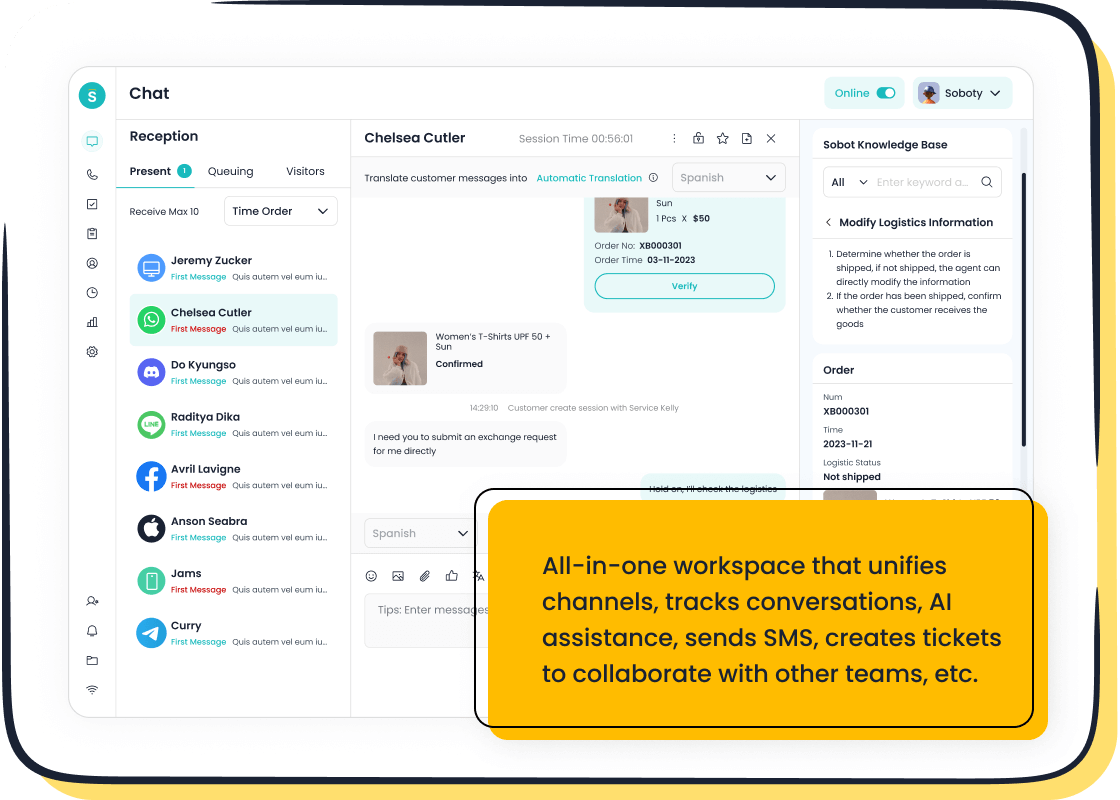
How Sobot Live Chat Improves Customer Engagement
Sobot Live Chat transforms how you connect with your customers by offering a seamless and efficient communication platform. Its advanced features ensure that every interaction feels personal and meaningful, which helps build trust and loyalty.
One of the key advantages of live chat support is its ability to enhance customer satisfaction. Sobot Live Chat achieves a remarkable 97% customer satisfaction rate, demonstrating its effectiveness in meeting customer needs. This high satisfaction stems from its ability to provide instant responses, reducing wait times and ensuring timely resolutions.
The platform also boosts agent efficiency by 30%, allowing your team to handle more inquiries without compromising quality. With tools like AI-assisted workflows and a unified workspace, agents can focus on delivering personalized solutions. This efficiency not only improves response times but also enhances the overall customer experience.
Sobot Live Chat supports omnichannel communication, enabling you to engage with customers across websites, apps, and social media platforms. This flexibility ensures that your customers can reach you through their preferred channels, making interactions more convenient. Additionally, features like customer segmentation and built-in analytics allow you to tailor your services to individual needs, further improving engagement.
For example, Sobot Live Chat’s precise profiling capabilities help turn visitors into loyal customers. Businesses using this tool have reported a 38% increase in conversion rates. By integrating with platforms like WhatsApp and Facebook, Sobot ensures that no customer query goes unanswered, fostering long-term relationships.
The advantages of live chat support extend beyond just communication. Sobot Live Chat empowers your business to deliver exceptional service, drive customer loyalty, and achieve measurable results.
Disadvantages of Live Chat
Higher Operational Costs
Live chat can be expensive to maintain, especially for businesses with limited resources. You need to invest in hiring skilled agents, providing competitive salaries, and offering benefits. These costs quickly add up, making live chat a costly option for customer support. Additionally, you must allocate funds for reliable technology, such as chat software and hardware, to ensure smooth operations.
Management and supervision also contribute to the expenses. Team leads and managers are essential for monitoring performance and maintaining service quality. For smaller companies, the initial setup costs can be overwhelming. Establishing an internal team requires significant financial resources. Furthermore, high turnover rates among support staff increase hiring and training expenses, leading to inefficiencies.
Here’s a breakdown of the cost factors associated with live chat:
| Cost Factor | Description |
|---|---|
| Employee Salaries and Benefits | The largest expense in setting up in-house live chat support, requiring competitive compensation. |
| Infrastructure and Technology Expenses | Investment in reliable technology, including chat software and hardware, is necessary. |
| Management and Supervision Costs | Costs for managers and team leads add to the overall financial burden. |
| High Initial Setup Costs | Significant initial expenses for establishing an internal team, especially for smaller companies. |
| Staffing Challenges and Turnover | High costs associated with hiring and retaining quality support staff, leading to operational inefficiencies. |
Limited Availability Without Additional Resources
Live chat depends on human agents, which limits its availability. Without additional resources, you may struggle to provide 24/7 support. This limitation can frustrate customers who need assistance outside of business hours. Expanding availability requires hiring more agents or outsourcing, both of which increase costs.
For businesses with global audiences, time zone differences add another layer of complexity. You must ensure that agents are available when your customers need them. Without proper planning, live chat may fail to meet customer expectations, impacting satisfaction and loyalty.
Potential for Longer Wait Times
When demand spikes, live chat can lead to longer wait times. Agents can only handle one conversation at a time, unlike chatbots that manage multiple queries simultaneously. If your team is understaffed, customers may experience delays, which can harm their perception of your brand.
Longer wait times often occur during peak hours or promotional events. Customers expect quick responses, and delays can lead to frustration. To address this issue, you need to optimize staffing levels and use tools like queue management systems. However, these solutions require additional investment, further increasing operational costs.
Dependency on Agent Skill Levels
The effectiveness of live chat often depends on the skills of your agents. Their ability to communicate clearly, solve problems, and empathize with customers directly impacts the quality of support. Skilled agents can turn a frustrated customer into a loyal one. However, less experienced agents may struggle to deliver the same level of service.
Training plays a crucial role in preparing agents for live chat. You need to invest time and resources to ensure they understand your products, services, and company policies. Without proper training, agents may provide incorrect information or fail to resolve issues effectively. This can lead to customer dissatisfaction and harm your brand's reputation.
Another challenge is maintaining consistency across your team. Each agent brings their own style and approach to conversations. While this can add a personal touch, it may also result in inconsistent experiences for customers. For example, one agent might resolve an issue quickly, while another might take longer or require additional assistance.
Agent turnover adds another layer of complexity. When experienced agents leave, you must train new hires to fill the gap. This process takes time and can temporarily reduce the efficiency of your live chat support. High turnover rates can also increase operational costs, making live chat a more expensive option.
Direct Comparison: Chatbot vs. Live Chat
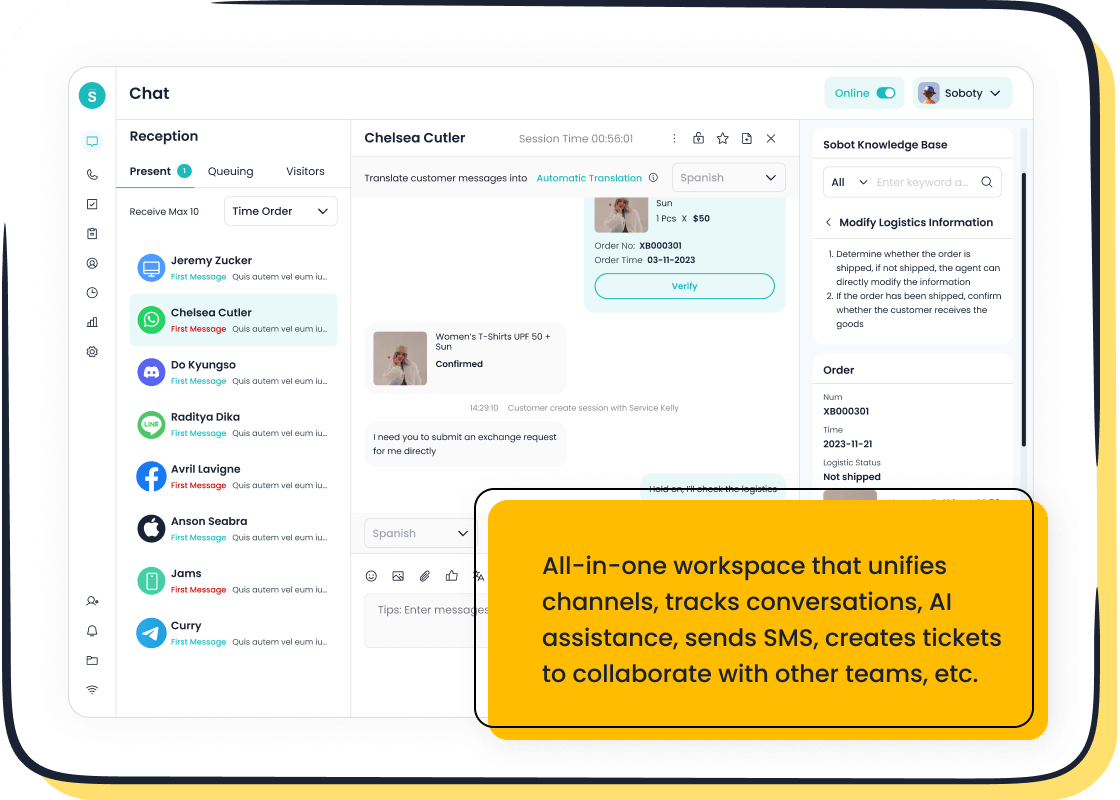
Cost and Operational Efficiency
When comparing chatbot vs. live chat, cost and operational efficiency are key factors. Chatbots offer a significant advantage in terms of scalability and cost-effectiveness. They require a one-time setup investment and can handle multiple queries simultaneously without additional staffing costs. For example, chatbots can save businesses over $8 billion annually by automating repetitive tasks. This efficiency allows you to scale operations during peak hours without incurring extra expenses.
In contrast, live chat involves recurring costs, such as agent salaries, training, and infrastructure. Each agent can only manage a limited number of conversations at a time, which increases costs as demand grows. The following table highlights these differences:
| Metric | Chatbots | Live Chat |
|---|---|---|
| Efficiency | Automates repetitive tasks | Resolves complex issues |
| Cost Considerations | One-time setup, scalable | Higher ongoing costs |
| Customer Experience | Fast responses, scalable | Personalized assistance |
By automating routine inquiries, chatbots reduce operational expenses, while live chat provides the human touch for more intricate issues.
Handling Complex Queries
Chatbots excel at managing simple and repetitive tasks, such as FAQs or order tracking. However, they often struggle with complex queries that require critical thinking or emotional understanding. For instance, AI chatbots may misinterpret nuanced questions, leading to customer frustration. On the other hand, live chat agents bring expertise and adaptability to the table. They can analyze intricate problems, clarify misunderstandings, and offer tailored solutions.
A hybrid approach can bridge this gap. Chatbots can handle initial inquiries and escalate complex issues to live agents. This strategy ensures quick responses while maintaining high-quality support. For example:
- Chatbots manage repetitive tasks, reducing agent workload.
- Live agents focus on resolving complex challenges.
- Combining both tools provides 24/7 support with seamless escalation.
This balance allows you to deliver efficient and effective customer service.
Customer Experience and Satisfaction
Customer experience is a critical factor when evaluating chatbot vs. live chat. Chatbots provide instant responses and consistent information, which enhances efficiency. They also use data to personalize interactions, creating a tailored experience. However, their lack of emotional understanding can lead to mixed satisfaction levels. As one study notes, consumers often prefer human-like qualities in chatbots to improve trust and engagement.
Live chat, on the other hand, excels in delivering empathy and personalized assistance. Human agents can interpret emotions and adapt their responses, fostering stronger connections. For example, 94% of customers report higher satisfaction with live chat due to its human touch. While chatbots offer speed and scalability, live chat provides the emotional depth that many customers value.
"Consumers exhibit skepticism towards chatbots compared to human interactions, leading to mixed satisfaction levels and aversion to minor errors."
By combining chatbots and live chat, you can balance efficiency with empathy, ensuring a superior customer experience.
Scalability and Availability
Scalability and availability are critical factors when choosing between live chat and chatbots for your customer support strategy. These aspects determine how well your system can handle increasing demands and provide consistent service.
Chatbots excel in scalability. They can manage thousands of conversations simultaneously without requiring additional resources. This makes them ideal for businesses experiencing high traffic or seasonal spikes. For example, during a holiday sale, a chatbot can handle multiple queries at once, ensuring no customer waits for assistance. Their 24/7 availability also ensures that your customers receive instant responses, regardless of time zones or business hours.
Live chat, on the other hand, offers a more personalized experience but faces limitations in scalability. Each agent can only handle a limited number of conversations at a time. To scale live chat support, you need to hire more agents, which increases operational costs. Additionally, live chat depends on agent availability, making it challenging to provide round-the-clock support without significant investment.
Combining both tools can create a balanced approach. Chatbots can handle repetitive queries and operate continuously, while live chat agents can focus on complex issues during business hours. This hybrid strategy ensures scalability and availability without compromising the quality of customer interactions.
By understanding the strengths of each tool, you can design a support system that meets your business needs and enhances customer satisfaction.
How Live Chat and Chatbots Can Complement Each Other
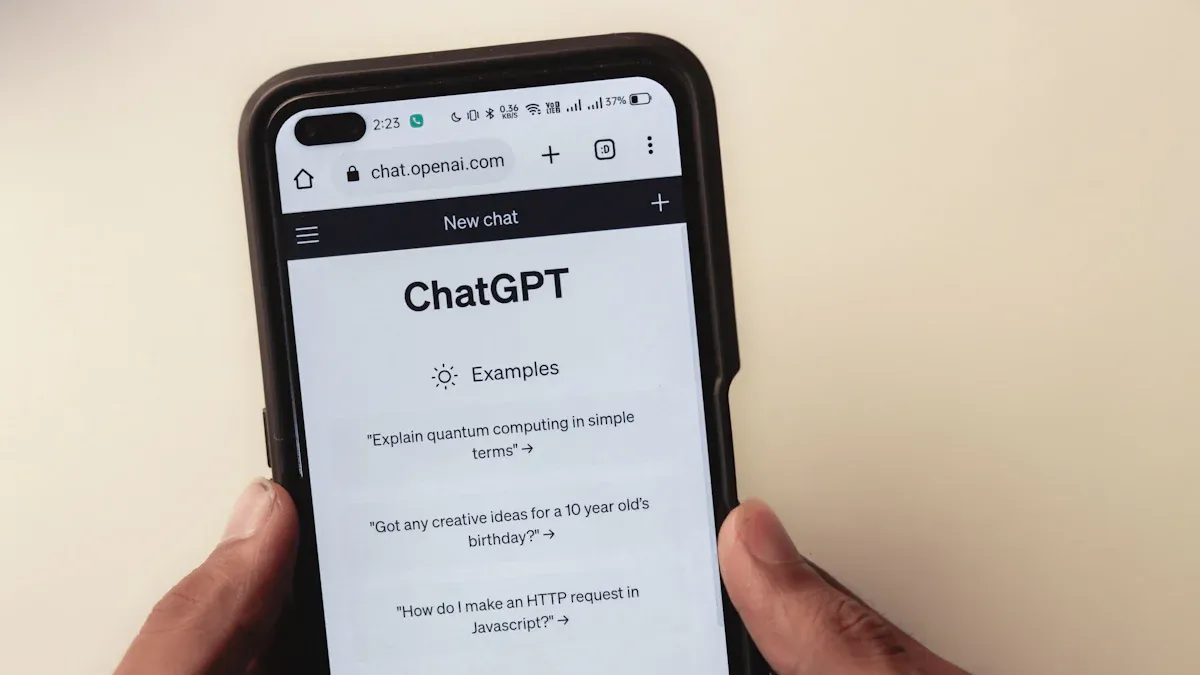
Combining Automation with Human Support
Combining live chat and chatbots creates a powerful customer support system. Chatbots handle repetitive tasks, such as answering FAQs or tracking orders, while live chat agents focus on complex issues. This partnership ensures efficiency and personalized service. For example, chatbots can instantly respond to inquiries, reducing wait times and preventing customer frustration. Meanwhile, live agents provide empathy and critical thinking for unique problems.
The benefits of this hybrid approach include improved response times, cost-effectiveness, and scalability. Chatbots operate continuously, managing high volumes of inquiries without increasing staffing costs. When integrated with CRM systems, they also deliver personalized interactions based on customer data. The table below highlights these advantages:
| Benefit | Description |
|---|---|
| Improved Response Times | AI chatbots provide instant responses, preventing delays and potential loss of customers. |
| Cost-Effectiveness | Chatbots minimize labor expenses by operating continuously and handling multiple inquiries simultaneously. |
| Personalized Interactions | When integrated with CRM systems, chatbots can deliver tailored responses based on customer data. |
| Scalability | Chatbots can manage higher volumes of inquiries without increasing staffing costs. |
| Enhanced Customer Engagement | Chatbots can assist during peak periods, allowing human agents to focus on complex issues. |
Using Chatbots for Initial Queries and Live Chat for Escalations
Using chatbots as the first line of support streamlines customer service. Chatbots handle initial queries, such as account details or order statuses, and escalate unresolved issues to live chat agents. This strategy ensures customers receive quick responses while reserving human expertise for more challenging problems.
Performance metrics support this approach. A high First Contact Resolution Rate indicates that many inquiries are resolved during the first interaction, boosting customer satisfaction. Quick Average Response Times maintain engagement, while high Customer Satisfaction Rates reflect the success of both chatbots and live agents. This balance allows businesses to deliver efficient and effective support.
Enhancing Customer Experience with Sobot's Hybrid Solutions
Sobot's hybrid solutions combine the strengths of live chat and chatbots to enhance customer experiences. The AI-powered chatbot handles basic inquiries, reducing inbound discussions by 20%. It also achieves an 80% accuracy rate in providing correct answers. When escalations occur, Sobot's live chat ensures seamless transitions, maintaining a 95% customer satisfaction rate.
The hybrid model improves efficiency and engagement. Customers report shorter wait times due to chatbots managing routine tasks. Human agents focus on complex issues, leading to a 97% Customer Satisfaction Score (CSAT). The chart below illustrates the impact of Sobot's hybrid solutions:
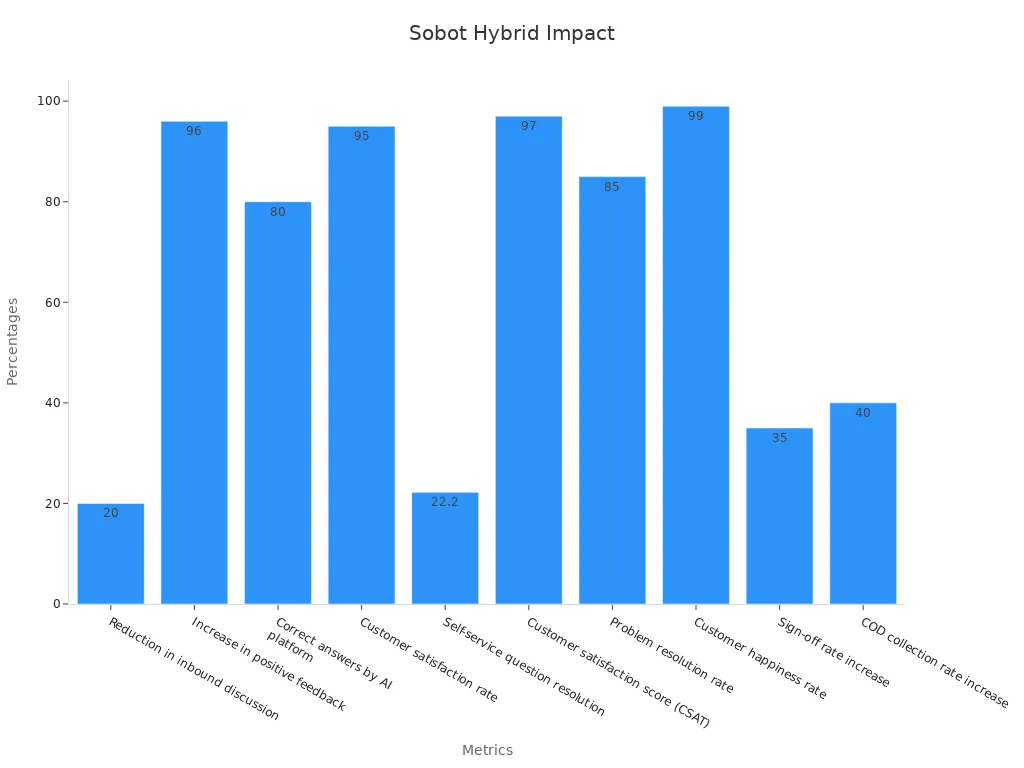
By integrating automation with human support, Sobot helps businesses deliver exceptional service, ensuring every customer feels valued.
Both live chat and chatbots bring unique strengths and weaknesses to customer support. Live chat excels in delivering personalized support and immediate responses, which boost customer satisfaction. However, it can be resource-intensive and limited in availability. Chatbots, on the other hand, offer 24/7 availability, scalability, and cost-effectiveness, but they may struggle with complex queries and lack a personal touch.
| Aspect | Live Chat | Chatbot |
|---|---|---|
| Strengths | Personalized support, immediate response, increased engagement | 24/7 availability, scalability, cost-effective |
| Weaknesses | Resource-intensive, limited availability, variable response quality | Limited understanding of complex queries, impersonal experience, dependency on scripting |
Sobot combines the best of both worlds with its hybrid solutions. By integrating live chat and chatbots, Sobot ensures efficient, scalable, and empathetic customer interactions. This approach allows you to meet diverse business needs while enhancing customer satisfaction. Choosing the right solution depends on your goals, but a hybrid strategy often delivers the most balanced results.
FAQ
1. How do I decide between live chat and chatbots for my business?
Evaluate your business needs. Use chatbots for 24/7 availability and cost efficiency. Choose live chat for personalized support and handling complex queries. A hybrid approach often works best, combining the strengths of both tools to meet diverse customer expectations.
2. Can live chat and chatbots work together?
Yes, they can complement each other. Chatbots handle repetitive tasks and initial queries. Live chat agents manage escalations and complex issues. This combination improves efficiency, reduces costs, and enhances customer satisfaction by providing both automation and human touch.
3. Are chatbots suitable for all industries?
Chatbots work well in industries with repetitive queries, like retail or e-commerce. However, industries requiring emotional understanding, such as healthcare, may benefit more from live chat. Assess your customer interaction needs to determine suitability.
4. What makes Sobot’s solutions unique?
Sobot offers advanced AI-powered chatbots and omnichannel live chat. These tools integrate seamlessly with platforms like Salesforce. They provide multilingual support, analytics, and personalized interactions, ensuring efficient and customer-centric service.
5. How can I measure the success of live chat or chatbots?
Track metrics like response time, resolution rate, and customer satisfaction scores. Use analytics tools to monitor performance. Sobot’s built-in analytics simplifies this process, helping you make data-driven decisions to improve customer support.
See Also
A Comprehensive Guide For Selecting Top Chatbot Solutions
Comparative Analysis of Leading Live Chat Tools for 2024
Key Advantages of Integrating Chatbots Into Your Website